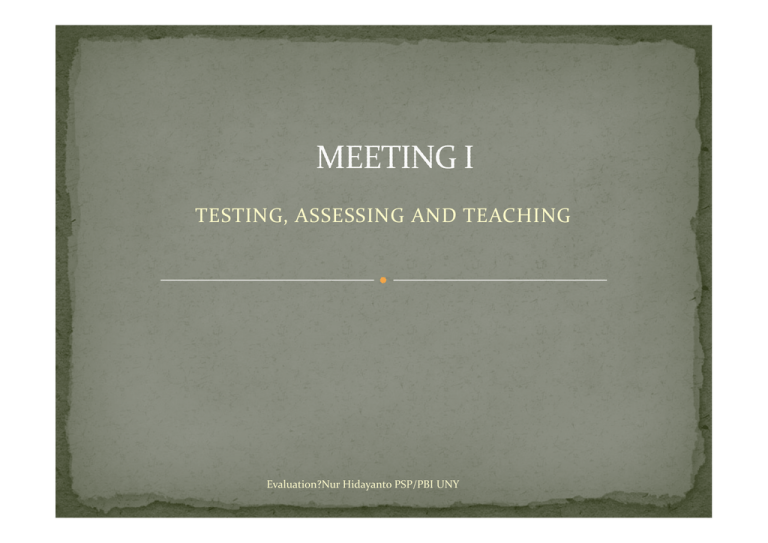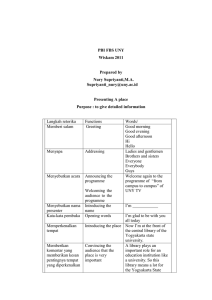TESTING, ASSESSING AND TEACHING Evaluation?Nur Hidayanto PSP/PBI UNY
advertisement

TESTING, ASSESSING AND TEACHING Evaluation?Nur Hidayanto PSP/PBI UNY Method of measuring a person’s ability, knowledge, or performance in a given domain. Evaluation?Nur Hidayanto PSP/PBI UNY Method instrument (a set of technique Measure data individual ability (trait) competence Evaluation?Nur Hidayanto PSP/PBI UNY Test: An instrument or activity used to accumulate data on a person’s ability/competence to perform a specified task. In kinesiology the content of these tests are usually either cognitive, skill, or fitness. Data: The translation of behavior into a numerical or verbal descriptor which is then recorded in written form. Evaluation?Nur Hidayanto PSP/PBI UNY To measure individual differences on a specific trait (behavior). Evaluation?Nur Hidayanto PSP/PBI UNY Is a test “good” if everyone/anyone scores 100%? Or, is a test “good” if everyone/anyone scores 0%? Evaluation?Nur Hidayanto PSP/PBI UNY To test: To measure individual differences on a specific trait (behavior). Evaluation?Nur Hidayanto PSP/PBI UNY Reflection Evaluation Motivation Achievement Improvement Diagnosis Prescription Grading Classification Prediction Evaluation?Nur Hidayanto PSP/PBI UNY teaching assessment tests Evaluation?Nur Hidayanto PSP/PBI UNY Evaluation?Nur Hidayanto PSP/PBI UNY Unplanned comments and responses Comments on students’ writing Evaluation?Nur Hidayanto PSP/PBI UNY Tests Journal Portfolio Evaluation?Nur Hidayanto PSP/PBI UNY One day Mr. Jono came to the class to give the students a writing assignment. First, he asked them to brainstorm their ideas. At the end of this first process, he wrote come notes on the result of their brainstorming. Some of the students got “Good Job”, but some got “Some more ideas please”. In this first process, he did not give any score to their writing. Next, he asked the students to make the outline for their compositions. He gave them 60 minutes to complete their outline. All the students would have to finish their outline in this process. After 60 minutes, he collected their outlines and scored them. Some students got 98 but some still got 60. Evaluation?Nur Hidayanto PSP/PBI UNY Evaluation?Nur Hidayanto PSP/PBI UNY Conducted during the process of forming students’ competencies: What is it for? To motivate, improve students’ competencies Examples:? Evaluation?Nur Hidayanto PSP/PBI UNY Conducted (typically) at the end of a course. To measure, summarize students’ competencies after a certain period of learning Examples? Evaluation?Nur Hidayanto PSP/PBI UNY Evaluation?Nur Hidayanto PSP/PBI UNY Students’ score is interpreted in relation to the mean (compared to the central tendencies) Example:? Evaluation?Nur Hidayanto PSP/PBI UNY Compared to the scores in the class/linked to the agreed criteria that if met show that a learner is ready to proceed to the next learning activity Example:? Evaluation?Nur Hidayanto PSP/PBI UNY DISCRETE-POINT AND INTEGRATIVE TESTING Evaluation?Nur Hidayanto PSP/PBI UNY Language can be broken down into its components parts (skills, phonology, syntax, etc) and can be tested separatedly. Evaluation?Nur Hidayanto PSP/PBI UNY Indivisible view of language proficiency, that language skills and the vocabulary, grammar, etc. are integrated. Evaluation?Nur Hidayanto PSP/PBI UNY What is it? That language tests should correspond to the demonstrable ways to language use in non-test situation. Evaluation?Nur Hidayanto PSP/PBI UNY Rely more on students’ performance in doing the tasks than on formally structured tests. Evaluation?Nur Hidayanto PSP/PBI UNY Evaluation?Nur Hidayanto PSP/PBI UNY IQ ------ 5 frames or even multiple intelligence Spatial intelligence Musical intelligence Bodily-kinesthetic intelligence Interpersonal intelligence Intrapersonal intelligence EQ------ESQ------ what other …..Q’s? Evaluation?Nur Hidayanto PSP/PBI UNY Traditional assessment Alternative assessment 1. One-shot, standardized exams 1. Continuous long-term assessment 2. Timed, multiple-choice format 2. Untimed, free-response format 3. Decontextualized test items 3. Contextualized communicative 4. Scores suffice for feedback 5. Norm-referenced scores 6. Focus on the ”right” answers tasks 4. Individualized feedback and washback 7. Summative 5. Criterion-referenced scores 8. Oriented to product 6. Open-ended, creative answers 9. Non-interactive performance 7. Formative 10. Fosters extrinsic motivation 8. Oriented to process 9. Interactive performance Evaluation?Nur Hidayanto PSP/PBI UNY 10. Fosters intrinsic motivation Evaluation?Nur Hidayanto PSP/PBI UNY Periodic assessments, both formal and informal can increase motivation by serving as milestones of students progress. Appropriate assessments aid in the reinforcement and retention of information. Assessments can confirm areas of strength and pinpoint areas needing further work. Assessments can provide a sense of periodic closure to modules within a curriculum. Assessments can promote student autonomy by encouraging students self evaluation of their progress. Assessments can spur learners to set goal for themselves. Assessments can aid in evaluating teaching effectiveness. Evaluation?Nur Hidayanto PSP/PBI UNY Evalua tion?N ur Hiday anto PSP/P What are the principles of language testing? How can we define them? What factors can influence them? How can we measure them? How do they interrelate? Evaluation?Nur Hidayanto PSP/PBI UNY Related to accuracy, dependability and consistency e.g. 20°C here today, 20°C in North Italy – are they the same? According to Henning [1987], reliability is a measure of accuracy, consistency, dependability, or fairness of scores resulting from the administration of a particular examination e.g. 75% on a test today, 83% tomorrow – problem with reliability. Evaluation?Nur Hidayanto PSP/PBI UNY Construct validity [internal] the extent to which evidence can be found to support the underlying theoretical construct on which the test is based Content validity [internal] the extent to which the content of a test can be said to be sufficiently representative and comprehensive of the purpose for which it has been designed Evaluation?Nur Hidayanto PSP/PBI UNY Response validity [internal] the extent to which test takers respond in the way expected by the test developers Concurrent validity [external] the extent to which test takers' scores on one test relate to those on another externally recognised test or measure Evaluation?Nur Hidayanto PSP/PBI UNY Predictive validity [external] the extent to which scores on test Y predict test takers' ability to do X e.g. IELTS + success in academic studies at university Face validity [internal/external] the extent to which the test is perceived to reflect the stated purpose e.g. writing in a listening test – is this appropriate? depends on the target language situation i.e. academic environment Evaluation?Nur Hidayanto PSP/PBI UNY 'Validity is not a characteristic of a test, but a feature of the inferences made on the basis of test scores and the uses to which a test is put.' Alderson [2002: 5] Evaluation?Nur Hidayanto PSP/PBI UNY Evaluation?Nur Hidayanto PSP/PBI UNY The ease with which the test: items can be replicated in terms of resources needed e.g. time, materials, people can be administered can be graded results can be interpreted Evaluation?Nur Hidayanto PSP/PBI UNY Factors which can influence reliability, validity and practicality… Evaluation?Nur Hidayanto PSP/PBI UNY quality of items number of items difficulty level of items level of item discrimination type of test methods number of test methods Evaluation?Nur Hidayanto PSP/PBI UNY time allowed clarity of instructions use of the test selection of content sampling of content invalid constructs Evaluation?Nur Hidayanto PSP/PBI UNY familiarity with test method attitude towards the test i.e. interest, motivation, emotional/mental state degree of guessing employed level of ability Evaluation?Nur Hidayanto PSP/PBI UNY consistency of administration procedure degree of interaction between invigilators and test takers time of day the test is administered clarity of instructions test environment – light / heat / noise / space / layout of room quality of equipment used e.g. for listening tests Evaluation?Nur Hidayanto PSP/PBI UNY accuracy of the key e.g. does it include all possible alternatives? inter-rater reliability e.g. in writing, speaking intra-rater reliability e.g. in writing, speaking machine vs. human Evaluation?Nur Hidayanto PSP/PBI UNY Test-retest same test administered to the same test takers following an interval of no more than 2 weeks Inter-rater reliability two or more independent estimates on a test e.g. written scripts marked by two raters independently and results compared Evaluation?Nur Hidayanto PSP/PBI UNY Internal consistency reliability estimates e.g. Split half reliability Cronbach’s alpha / Kuder Richardson 20 [KR20] Evaluation?Nur Hidayanto PSP/PBI UNY test to be administered to a group of test takers is divided into halves, scores on each half correlated with the other half the resulting coefficient is then adjusted by SpearmanBrown Prophecy Formula to allow for the fact that the total score is based on an instrument that is twice as long as its halves Evaluation?Nur Hidayanto PSP/PBI UNY this approach looks at how test takers perform on each individual item and then compares that performance against their performance on the test as a whole measured on a -1 to +1 scale like discrimination Evaluation?Nur Hidayanto PSP/PBI UNY the longer the test, the more reliable it is likely to be [though there is a point of no extra return] items which discriminate will add to reliability, therefore, if the items are too easy / too difficult, reliability is likely to be lower if there is a wide range of abilities amongst the test takers, test is likely to have higher reliability the more homogeneous the items are, the higher the reliability is likely to be Evaluation?Nur Hidayanto PSP/PBI UNY According to Henning [1987] non-empirically, involving inspection, intuition and common sense empirically, involving the collection and analysis of qualitative and quantitative data Evaluation?Nur Hidayanto PSP/PBI UNY Construct validity evidence is usually obtained through such statistical analyses as factor analysis [looks for items which group together], discrimination; also through retrospection procedures Content validity this type of validity cannot be measured statistically; need to involve experts in an analysis of the test; detailed specifications should be drawn up to ensure the content is both representative and comprehensive Evaluation?Nur Hidayanto PSP/PBI UNY Response validity can be ascertained by means of interviewing test takers [Henning]; asking them to take part in introspection / retrospection procedures [Alderson] Concurrent validity determined by correlating the results on the test with another externally recognised measure. Care needs to be taken that the two measures are measuring similar skills and using similar test methods Evaluation?Nur Hidayanto PSP/PBI UNY Predictive validity can be determined by investigating the relationship between a test taker's score e.g. on IELTS/TOEFL and his/her success in the academic program chosen problem - other factors may influence success e.g. life abroad, ability in chosen field, peers, tutors, personal issues, etc.; also time factor element Evaluation?Nur Hidayanto PSP/PBI UNY 'an observation can be reliable without being valid, but cannot be valid without first being reliable. In other words, reliability is a necessary, but not sufficient, condition for validity.' [Hubley & Zumbo 1996] ‘Of all the concepts in testing and measurement, it may be argued, validity is the most basic and farreaching, for without validity, a test, measure or observation and any inferences made from it are meaningless’ [Hubley & Zumbo 1996, 207] Evaluation?Nur Hidayanto PSP/PBI UNY even an ideal test which is perfectly reliable and possessing perfect criterion-related validity will be invalid for some purposes [Henning 1987] Evaluation?Nur Hidayanto PSP/PBI UNY Designing and developing good test items requires working with other colleagues materials i.e. paper, computer, printer etc. time Some items look very attractive but this attraction has to be weighed against these factors. Evaluation?Nur Hidayanto PSP/PBI UNY Alderson, J. C 2002 Conceptions of validity and validation. Paper presented at a conference in Bucharest, June 2002. Angoff, 1988 Validity: An evolving concept. In H. Wainer & H. Braun [Eds.] Test validity [pp. 19-32], Hillsdale, NJ: Erlbaum. Bachman, L. F. 1990 Fundamental considerations in language testing. Oxford: O.U.P. Cumming A. & Berwick R. [Eds.] Validation in Language Testing Multilingual Matters 1996 Hatch, E. & Lazaraton, A. 1991 The Research Manual - Design & Statistics for Applied Linguistics Newbury House Evaluation?Nur Hidayanto PSP/PBI UNY Henning, G. 1987 A guide to language testing: Development, evaluation and research Cambridge, Mass: Newbury House Hubley, A. M. & Zumbo, B. D. A dialectic on validity: where we have been and where we are going. The Journal of General Psychology 1996. 123[3] 207-215 Messick, S. 1988 The once and future issues of validity: Assessing the meaning and consequences of measurement. In H. Wainer & H. Braun [Eds.] Test validity [pp. 33-45], Hillsdale, NJ: Erlbaum. Messick, S. 1989 Validity. In R. L. Linn [Ed.] Educational measurement. [3rd ed., pp 13-103]. New York: Macmillan. Evaluation?Nur Hidayanto PSP/PBI UNY Item-total Statistics R01 R02 R03 R04 R05 R16 Corrected Item-Total Correlation .5259 .6804 .6683 .5516 .7173 .3946 N of Cases = 194.0 Alpha if Item Deleted .7964 .7594 .7623 .7940 .7489 .8288 N of Items = 6 Alpha = .8121 Evaluation?Nur Hidayanto PSP/PBI UNY Item-total Statistics Corrected Item Total Correlation R16 R17 R18 R19 R20 R01 Alpha if Item Deleted .5773 .5995 N of Cases = .7909 .7863 .7351 .7920 .6490 .1939 .7553 .7419 .7753 .8663 194.0 N of Items = 6 Alpha = .8185 Evaluation?Nur Hidayanto PSP/PBI UNY Component Matrixa R01 R02 R03 R04 R05 R16 R17 R18 R19 R20 Component 1 2 .502 .559 .690 .423 .683 .461 .571 .404 .750 .343 .670 -.223 .631 -.508 .770 -.368 .789 -.383 .646 -.494 Extraction Method: Principal Component Analysis. a. 2 components extracted. Evaluation?Nur Hidayanto PSP/PBI UNY 3 RD MEETING Evaluation?Nur Hidayanto PSP/PBI UNY 1. What is the purpose of the test? Placement or achievement, or……. 2. What are the objectives of the test? What skills/competencies to measure 3. How will the test specifications reflect both the purpose and the objective 4. How will the test tasks be selected and the separate items arranged? 5. What kind of scoring, grading, and/or feedback is expected? Evaluation?Nur Hidayanto PSP/PBI UNY Language aptitude tests Measure capacity or general ability to learn a foreign language and ultimate success in that undertaking. Proficiency tests Measuring global competence in language (all the skills) Placement tests To place a student into a particular level or section of language curriculum or school. Diagnostic tests To diagnose specified aspects of a language, e.g. to diagnose difficulties found by students in a certain skill. Achievement tests Related directly to classroom lessons, units, or even a total curriculum. Evaluation?Nur Hidayanto PSP/PBI UNY 1. Assessing clear, unambiguous objectives A teacher said that he wanted to test his students listening skills. Is it a clear objective? So, what is a good test objective? Task 1 Read the SK/KD in SMP/SMA. Select some objectives for integrated-skills course. You can find the example on page 50. Evaluation?Nur Hidayanto PSP/PBI UNY 2. Drawing up test specification Test specifications: drawn from the selected objectives Example: page 52 Task 2: Write your test specification. Refer to the objectives you have chosen before. Evaluation?Nur Hidayanto PSP/PBI UNY 3. Devising Test Tasks Drafting the questions that you are going to use in a test. Things to consider: a. clear directions to each section b. examples: need or not c. Each item measures a certain objective. d. Each item is stated in clear, simple language. e. Each item in the multiple choice section should have good distractors. f. Each item should have the right level of difficulty. g. Each item should have sufficient authentic language. h. The sum of all the items should reflect the learning objectives. Evaluation?Nur Hidayanto PSP/PBI UNY Strengths? Weaknesses? Characteristics: All receptive or selective response item Each item consists of a stem and some alternatives. For each item, there is only one key, while the rest of the alternatives are distractors. Evaluation?Nur Hidayanto PSP/PBI UNY Design each item to measure a specific objective. State both stem and options as simply and directly as possible. Make sure that the intended answer is clearly the only correct option. Use item indices to accept, discard, or revise items. Evaluation?Nur Hidayanto PSP/PBI UNY Develop your own 10 item-English multiple choice test by following the steps to design a multiple choice item. Here is an example. Ite m Skill & Objective 1 Listening Comprehension of WH-questions Stem Alternatives When did the students have a. Yes, they did. the final exam? b. Yesterday c. In the English class d. With Mr. Jono Evaluation?Nur Hidayanto PSP/PBI UNY

